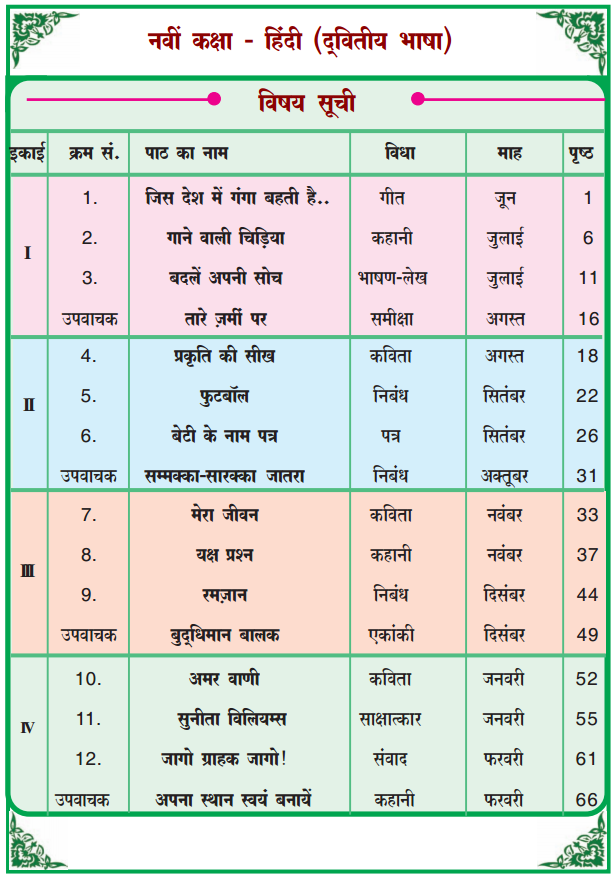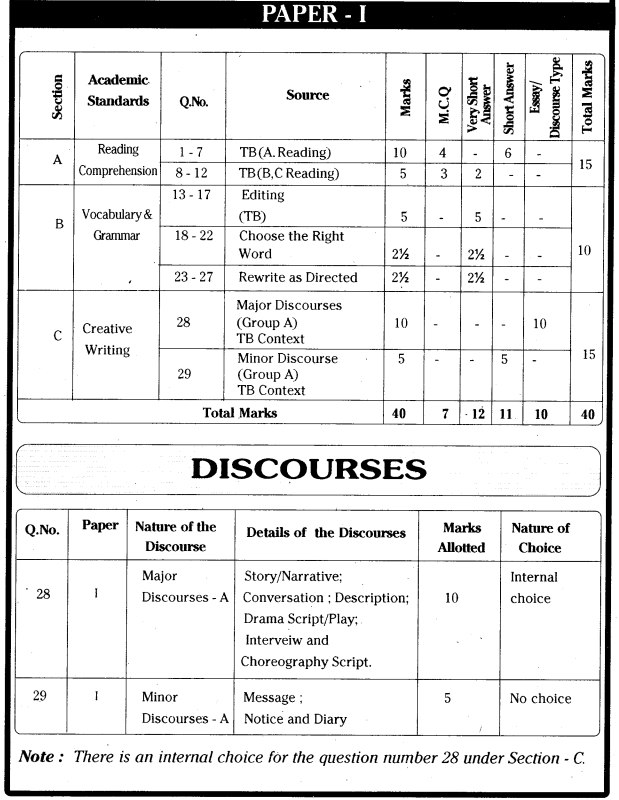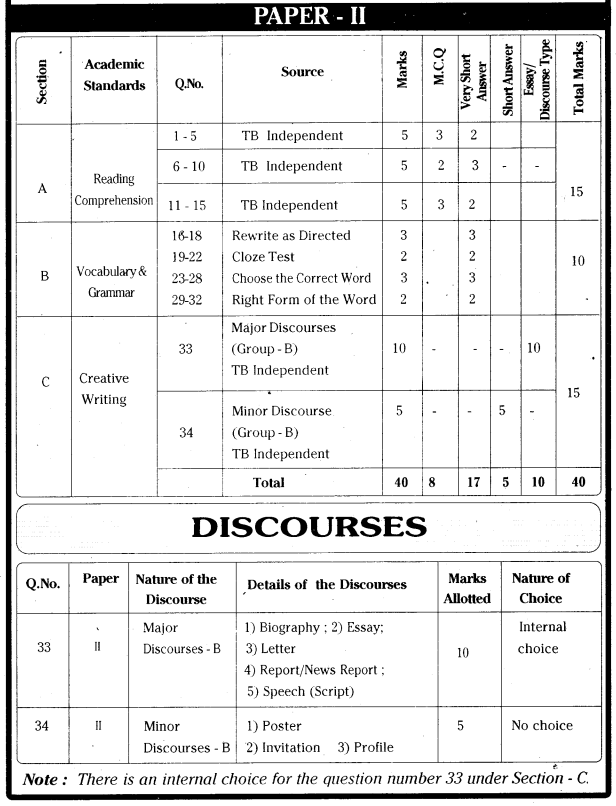These TS 9th Class Hindi Bits with Answers 9th Lesson रमज़ान will help students to enhance their time management skills.
TS 9th Class Hindi Bits 9th Lesson रमज़ान
प्रश्न 1.
रमज़ान उपवासों का पावन पर्व है। रेखांकित शब्द का शब्द भेद पहचानिए।
A) संज्ञा
B) विशेषण
C) सर्वनाम
D) क्रिया
उत्तर :
B) विशेषण
प्रश्न 2.
रमज़ान हमें सद्भावना के सूत्र में बांधकर मानव कल्याण का संदेश देता है। रेखांकित शब्द का संधि विच्छेद पहचानिए।
A) सद् + भावना
B) सद् + भ भावना
C) सत् + भावना
D) ये सब
उत्तर :
C) सत् + भावना

प्रश्न 3.
ईद ……. दिन सब नये कपडे पहनते हैं। उचित कारक चिह्न से रिक्त स्थान की पूर्ति कीजिए।
A) का
B) के
C) से
D) में
उत्तर :
B) के
प्रश्न 4.
शीरख़ुर्मा – का अर्थ पहचानिए।
A) सेवइयाँ
B) मटर
C) नाश्ता
D) आटा
उत्तर :
A) सेवइयाँ

प्रश्न 5.
वह छोटा लडका है। रेखांकित शब्द का विलोम पहचानिए।
A) नाटा
B) लंबा
C) मोटा
D) बडा
उत्तर :
D) बडा
प्रश्न 6.
वह बड़ा आदमी है। रेखांकित शब्द, शब्द भेद की दृष्टि से क्या है?
A) संज्ञा
B) विशेषण
C) सर्वनाम
D) क्रिया
उत्तर :
B) विशेषण
प्रश्न 7.
ईद के दिन सब नये कपडे पहनते हैं। इस वाक्य में विशेषण शब्द पहचानिए।
A) ईद
B) दिन
C) नये
D) पहनते
उत्तर :
C) नये

प्रश्न 8.
यह दृश्य देखने लायक होता है। यह वाक्य किस काल में है?
A) भूत
B) भविष्यत
C) संदिग्ध भूत
D) वर्तमान
उत्तर :
D) वर्तमान
प्रश्न 9.
विविध धर्मों ……. लोग भी ईद की शुभकामनाएँ देते हैं। रिक्त स्थान की पूर्ति उचित कारक चिहन से कीजिए।
A) की
B) के
C) में
D) को
उत्तर :
B) के
प्रश्न 10.
अमीर – गरीब समास पहचानिए।
A) द्विगु
B) ट्वंद्व
C) तत्पुरुष
D) कर्मधारय
उत्तर :
B) ट्वंद्व

प्रश्न 11.
समाज में शांति नहीं तो देश की उन्नति नहीं होती। रेखांकित शब्द का विलोम पहचानिए।
A) शांतिहीन
B) शांतिरहित
C) अशांति
D) नशांति
उत्तर :
C) अशांति
प्रश्न 12.
महात्मा गाँधीजी अहिसा के पुजारी थे। रेखांकित शब्द में उपसर्ग पहचानिए।
A) हिंसा
B) सा
C) अ
D) अह्हि
उत्तर :
C) अ
प्रश्न 13.
कमर कसना – इस मुहावरे का अर्थ पहचानिए।
A) तत्पर होना
B) मार डालना
C) रो पडना
D) डाँटना
उत्तर :
A) तत्पर होना

प्रश्न 14.
इस्लामी महीना चाँद के निकलने से शुरु होता है। रेखांकित शब्द का विलोम पहचानिए।
A) आरंभ
B) अंत
C) प्रारंभ
D) आदि
उत्तर :
B) अंत
प्रश्न 15.
सुचना विविध प्रकार से दी जायेगी। रेखांकित शब्द का वचल बदलकर लिखिए।
A) सूचना
B) सूचनाएँ
C) सूचनें
D) सूचनों
उत्तर :
B) सूचनाएँ
प्रश्न 16.
तैयारी शब्द का वचन बदलकर लिखिए।
A) तैयारियाँ
B) तैयारी
C) तैयारों
D) तैयारें
उत्तर :
A) तैयारियाँ
प्रश्न 17.
रोज़ा का अर्थ क्या है?
A) उपवास
B) व्रत
C) पूजा
D) प्रार्थना
उत्तर :
A) उपवास

प्रश्न 18.
सूर्योदय – संधि विच्छेद पहचानिए।
A) सूर्य + ओदय
B) सूर्य + उदेय
C) सूर्य + उदय
D) सू + र्योदय
उत्तर :
C) सूर्य + उदय
प्रश्न 19.
सहरी के बाद ……. उपवास आरंभ होता है। रिक्त स्थान की पूर्ति उचित कारक चिह्न से कीजिए।
A) में
B) से
C) के
D) की
उत्तर :
B) से
प्रश्न 20.
उपवास में पानी तक पीना मना है। अर्थ की दृष्टि से यह वाक्य क्या है?
A) विधानार्थक
B) निषेर्धार्थक
C) इच्छार्थक
D) प्रश्नार्थक
उत्तर :
B) निषेर्धार्थक

प्रश्न 21.
दैनिक कार्य – समास पहचानिए।
A) कर्मधारय
B) तत्पुरुष
C) द्विगु
D) द्वंद्व
उत्तर :
B) तत्पुरुष
प्रश्न 22.
रोज़ा रखने से मनुष्य स्वस्थ बना रहता है। रेखांकित शब्द का भाषा – भाग पहचानिए।
A) संज्ञा
B) सर्वनाम
C) क्रिया
D) विशषण
उत्तर :
D) विशषण
प्रश्न 23.
मन ………. अक्काह की इबादत में लगाना रमज़ान का मुख्य उद्देश्य है ।उचित कारक चिह्न से रिक्त स्थान की पूर्ति कीजिए।
A) के
B) से
C) को
D) में
उत्तर :
C) को

प्रश्न 24.
आत्मानुशासन – संधि विच्छेद कीजिए।
A) आत्म + आनुशासन
B) आत्मो + अनोशसन
C) आत्मा + अनुशासन
D) आतम + अनुशासन
उत्तर :
C) आत्मा + अनुशासन
प्रश्न 25.
मानवता – में प्रत्यय पहचानिए।
A) ता
B) मा
C) मान
D) वता
उत्तर :
A) ता
प्रश्न 26.
इससे सामाजिकता की भावना बढ़ती है। रेखांकित शब्द का वचन बदलने पर
A) भावनाएँ
B) भाव
C) भावनों
D) भावनें
उत्तर :
A) भावनाएँ

प्रश्न 27.
वह गरीब लडका है। रेखांकित शब्द का विलोम पहचानिए।
A) अमीर
B) निर्धनी
C) बेपरवाह
D) ये सब
उत्तर :
A) अमीर
प्रश्न 28.
परोपकार – संधि विच्छेद पहचानिए।
A) पर + उपकार
B) परा + उपकार
C) परो + पकार
D) परम + उपकार
उत्तर :
B) परा + उपकार
प्रश्न 29.
‘विकास’ – विलोम शब्द पहचानिए।
A) हास
B) उन्नति
C) अवन्नति
D) प्रगति
उत्तर :
A) हास

प्रश्न 30.
मानव में त्याग भावना होनी चाहिए। रेखांकित शब्द का विलोम पहचानिए।
A) बलिदान
B) कुली
C) स्वार्थ
D) नरम
उत्तर :
C) स्वार्थ
प्रश्न 31.
‘पथ’ – शब्द का अर्थ पहचानिए।
A) मार्ग
B) कीमत
C) भाव
D) उपद्रव
उत्तर :
A) मार्ग
प्रश्न 32.
वातावरण – संधि विच्छेद पहचानिए।
A) वात + वरण
B) वाता + आवरण
C) वातो + रण
D) वाते + आरण
उत्तर :
B) वाता + आवरण

प्रश्न 33.
रमजान एक धार्मिक पर्व है। रेखांकित शब्द का प्रत्यय पहचानिए।
A) धा
B) र्मिक
C) इक
D) क
उत्तर :
C) इक
प्रश्न 34.
महत्वपूर्ण त्यौहारों में रमजान एक है। रेखांकित शब्द का विलोम पहचानिए।
A) महत्वहीन
B) महत्वपूर्ति
C) महान
D) महानहीन
उत्तर :
A) महत्वहीन
प्रश्न 35.
पाँच फ़र्ज – समास पहचानिए।
A) द्विगु
B) द्वंद्व
C) तत्पुरुष
D) कर्मधारय
उत्तर :
A) द्विगु

प्रश्न 36.
परोपकार – शब्द का विलोम पहचानिए।
A) परहानि
B) परधर्म
C) परसेवा
D) ये सब
उत्तर :
A) परहानि
प्रश्न 37.
मानवसेवा – समास पहृचानिए।
A) कर्मधारय
B) तत्पुरुष
C) अव्ययीभाव
D) द्वंद्व
उत्तर :
B) तत्पुरुष
प्रश्न 38.
यह जागने की रात है। रेखांकित शब्द का विलोम पहचानिए।
A) हैंसना
B) रोना
C) सोना
D) खाना
उत्तर :
C) सोना
प्रश्न 39.
बत्चे – बन्चे भी बडों के साथ रात भर जागते हैं। इस वाक्य में पुनरुक्ति शब्द पहचानिए।
A) भी
B) बच्चे – बच्चे
C) के साथ
D) रात भर
उत्तर :
B) बच्चे – बच्चे

प्रश्न 40.
इसमें समाज कल्याण की भावना है। रेखांकित शब्द का अर्थ है
A) विवाह
B) शादी
C) शुभ
D) अशुभ
उत्तर :
C) शुभ
प्रश्न 41.
भारत प्राचीन और विशाल देश है। इस वाक्य में विशेषण शब्दों को पहचानिए।
A) भारत, और
B) प्राचीन, विशाल
C) देश
D) है
उत्तर :
B) प्राचीन, विशाल
प्रश्न 42.
“लोग” शब्द का पर्याय पहचानिए।
A) जनता
B) धरित्री
C) पूर्वज
D) संताप
उत्तर :
A) जनता

प्रश्न 43.
त्यौहार शब्द का पर्याय पहचानिए।
A) पर्व
B) उत्साह्
C) उक्कास
D) भीड
उत्तर :
A) पर्व
प्रश्न 44.
त्यौहार समाज में ख़शी और सजगता लाते हैं। रेखांकित शब्द में प्रत्यय पहचानिए।
A) खु
B) शी
C) ई
D) खुश
उत्तर :
C) ई
प्रश्न 45.
त्यौहार भारतीय संरकृति की शोभा में चार चाँद लगाते हैं। इस वाक्य में मुहावरेवाले शब्द को पहचानिए।
A) भारतीय संस्कृति
B) संसकृति शोभा
C) चार चॉँद लगाना
D) त्यौहार और संस्कृति
उत्तर :
C) चार चॉँद लगाना

प्रश्न 46.
ऐसे ही महत्वपूर्ण त्यौहारों ‘ईद – उल – फितर’ भी एक है। रिक्त स्थानों की पूर्ति उचित कारक चिहनों से कीजिए।
A) के, से
B) में, से
C) से, ने
D) के, के
उत्तर :
B) में, से
प्रश्न 47.
वारतव में रमज़ान इस्लाम धर्म का एक महीने का नाम है। रेखांकित शब्द का विलोम पहचानिए।
A) यदार्थ
B) निजी
C) अवास्तव
D) ये सब
उत्तर :
C) अवास्तव
प्रश्न 48.
“पाँच सिद्धांत”‘ समास पहचानिए।
A) द्वंद्व
B) द्विगु
C) तत्पुरुष
D) कर्मधारय
उत्तर :
B) द्विगु
प्रश्न 49.
“इबादत'” अर्थ पहचानिए।
A) प्रार्थना
B) कृपा
C) दया
D) भ्रमण
उत्तर :
A) प्रार्थना

प्रश्न 50.
रमज़ान वास्तव में एक महीने का नाम है। रेखांकित शब्द का अर्थ पहचानिए।
A) धर्म
B) मास
C) सास
D) प्यास
उत्तर :
B) मास
प्रश्न 51.
“पवित्र”‘ शब्द का विलोम पहचानिए।
A) पवित्रता
B) अपवित्र
C) चरित्र
D) इतिहास
उत्तर :
B) अपवित्र
प्रश्न 52.
इस्लामी – में प्रत्यय पहचानिए।
A) इं
B) इस्ल
C) मी
D) ई
उत्तर :
D) ई

प्रश्न 53.
त्योहार मानवता का संदेश देते हैं। अर्थ की दृष्टि से इस वाक्य को पहचानिए।
A) विधानार्थक
B) संदेहार्थक
C) संकेतार्थक
D) विसमयार्थक
उत्तर :
A) विधानार्थक
प्रश्न 54.
छात्रों में सद्भावना ….. संस्कृति का विकास हमें कराना है। रिक्त स्थान की पूर्ति उचित शब्द से कीजिए।
A) यदि
B) बल्कि
C) तो
D) और
उत्तर :
D) और
प्रश्न 55.
भारत प्राचीन देश है। शब्द भेद की दृष्टि से रेखांकित शब्द क्या है?
A) क्रिया
B) संज्ञा
C) विशेषण
D) सर्वनाम
उत्तर :
C) विशेषण
प्रश्न 56.
ईद – उल – फ़ितर को रंजान भी कहते हैं। रचना की दृष्टि से इस वाक्य को पहचानिए।
A) सरल
B) शिथिल
C) मिश्रित
D) संयुक्त
उत्तर :
A) सरल

प्रश्न 57.
कुरान पवित्र ग्रंथ है। इस वाक्य में विशेषण शब्द पहचानिए।
A) कुरान
B) ग्रंथ
C) है
D) पवित्र
उत्तर :
D) पवित्र
प्रश्न 58.
तैयारी – शब्द का वचन बदलने से
A) तैयारियाँ
B) तैयार
C) तैयारी
D) तैयारियों
उत्तर :
A) तैयारियाँ
प्रश्न 59.
सूचना – वचन बदलने से
A) सूचना
B) सूचनें
C) सूचनाइयाँ
D) सूचनाएँ
उत्तर :
D) सूचनाएँ

प्रश्न 60.
उपवास में पानी तक पीना मना है। अर्थ की दृष्टि से वाक्य पहचानिए।
A) विधानार्थक
B) आज्ञार्थक
C) निषेधार्थक
D) संकेतार्थक
उत्तर :
C) निषेधार्थक
प्रश्न 61.
गरीबों के दुख दर्दों का अनुभव किया जाता है। रेखांकित शब्द का विलोम पहचानिए।
A) दरिद्र
B) अमीर
C) अगरीब
D) निर्धन
उत्तर :
B) अमीर
प्रश्न 62.
कुरान का पाठ – पठन किया जाता है। रेखांकित शब्द का शब्द भेद पहचानिए।
A) सर्वनाम
B) संज्ञा
C) क्रिया
D) विशेषण
उत्तर :
B) संज्ञा

प्रश्न 63.
सोना – शब्द का पर्याय पहचानिए।
A) कनक
B) चाँदी
C) ताँबा
D) अभ्रक
उत्तर :
A) कनक
प्रश्न 64.
ढाई प्रतिशत – समास पहचानिए।
A) तत्पुरुष
B) द्वंद्व
C) द्विगु
D) कर्मधारय
उत्तर :
C) द्विगु
प्रश्न 65.
इत्यादि – शब्द का संधि विच्छेद पहचानिए।
A) इत + आदि
B) इति + आदि
C) इतो + आदि
D) ये सब गलत ही है
उत्तर :
B) इति + आदि
प्रश्न 66.
बूढा चल रहा है। रेखांकित शब्द का लिंग बदलकर लिखिए।
A) बूढ़ा
B) बूढ़ी
C) बूढे
D) बूढों
उत्तर :
B) बूढ़ी

प्रश्न 67.
भारत अनेक जातियों के लोग रहते हैं। रिक्त स्थान की पूर्ति उचित कारक चिहन से कीजिए।
A) के
B) की
C) से
D) में
उत्तर :
D) में
प्रश्न 68.
रमज़ान इस्लाम धर्म प्रमुख त्यौहार है। रिक्तस्थान की पूर्ति उचित कारक चिहन से कीजिए।
A) के
B) की
C) को
D) का
उत्तर :
D) का
प्रश्न 69.
दैनिक – में प्रत्यय पहचानिए।
A) दै
B) दैन
C) निक
D) इक
उत्तर :
D) इक

प्रश्न 70.
रोज़ा रखने से मनुष्य स्वस्थ व चुस्त बना रहता है। इस वाक्य का काल पहचानिए।
A) वर्तमान
B) भूत
C) भविष्यत
D) संदिग्ध भूत
उत्तर :
A) वर्तमान
प्रश्न 71.
प्राचीन विशाल और देश है भारत। सीधे क्रम में रखिए।
A) भारत प्राचीन और विशाल देश है
B) भारत विशाल और है प्राचीन
C) भारत है विशाल प्राचीन और
D) ये सब सही।
उत्तर :
A) भारत प्राचीन और विशाल देश है
प्रश्न 72.
भारत प्राचीन देश है। रेखांकित शब्द क्या है ?
A) संझ्ञा
B) विशेषण
C) क्रिया
D) सर्वनाम
उत्तर :
B) विशेषण
प्रश्न 73.
त्यौहार भारतीय संसकृति की शोभा में चार चादँ लगाते हैं। इस वाक्य में रेखांकित शब्द को क्या कहते हैं?
A) कारक
B) संज्ञा
C) कहावत
D) मुहावरे
उत्तर :
D) मुहावरे

प्रश्न 74.
अन्वेषण – शब्द का संधि विच्छेद पहचानिए।
A) अण + एषण
B) अनु + एषण
C) अ + वेषण
D) अनम + वेषण
उत्तर :
B) अनु + एषण
प्रश्न 75.
एक सूत्र में बाँधना – इस मुहावरे का अर्थ पहचानिए।
A) संघटित करना
B) भाग जाना
C) फैल जाना
D) सिर पीटना
उत्तर :
A) संघटित करना
प्रश्न 76.
लडके से दौडा नहीं जाता । इस वाक्य का वाच्य पहचानिए।
A) कर्तृ
B) कर्म
C) भाव
D) अकर्म
उत्तर :
C) भाव
प्रश्न 77.
लडके से रोटी खायी जाती है।
A) कर्म
B) कर्तृ
C) भाव
D) अकर्म
उत्तर :
A) कर्म

प्रश्न 78.
वृद्धि – विलोम पहचानिए।
A) कमी
B) छोटी
C) बडी
D) ये सब
उत्तर :
A) कमी
प्रश्न 79.
जीविका शब्द का अर्थ पहचानिए।
A) प्राण
B) जीवन आधार
C) जन पथ
D) सागर
उत्तर :
B) जीवन आधार
प्रश्न 80.
पर्व हमें एक सूत्र में बाँधकर मानव कल्याण का संदेश देता है। इस वाक्य में क्रिया शब्द को पहचानिए।
A) पर्व
B) सूत्र
C) बाँध
D) देता है
उत्तर :
D) देता है
प्रश्न 81.
कपडा – वचन बदलने से
A) कपडॉ
B) कपडाइयाँ
C) कपडे
D) कपडा
उत्तर :
C) कपडे

प्रश्न 82.
खुशी – शब्द का वचन बदलने से –
A) खुशी
B) खुशें
C) खुशियों
D) खुशाइयाँ
उत्तर :
C) खुशियों
प्रश्न 83.
वातावरण – संधि विच्छेद पहचानिए।
A) वात + वरण
B) वाता + आवरण
C) वातो + वरण
D) वाते + आरण
उत्तर :
B) वाता + आवरण
प्रश्न 84.
चारों ओर – समास पहचानिए।
A) द्विगु
B) द्वंद्व
C) कर्मधारय
D) तत्पुरुष
उत्तर :
A) द्विगु
प्रश्न 85.
मानव सेवा – सम्सा पहचानिए।
A) तत्पुरुष
B) द्विगु
C) द्वंद्व
D) कर्मधारय
उत्तर :
A) तत्पुरुष

प्रश्न 86.
विश्व कल्याण – समास पहचानिए।
A) द्विगु
B) कर्मधारय
C) तत्पुरुष
D) अव्ययीभाव
उत्तर :
C) तत्पुरुष
प्रश्न 87.
रमज़ान इस्लाम धर्म का प्रमुख त्यौहार है। शब्द भेद की दृष्टि से रेखांकित शब्द क्या है? ()
A) क्रिया
B) संज्ञा
C) कारक
D) विशेषण
उत्तर :
B) संज्ञा
प्रश्न 88.
इबादत – इसका अर्थ पहचानिए।
A) प्रार्थना
B) वेदना
C) पीडा
D) कर्म
उत्तर :
A) प्रार्थना

प्रश्न 89.
‘कल्याण’ शब्द का विलोम है
A) शुभ
B) पवित्र
C) पावन
D) अकल्याण
उत्तर :
D) अकल्याण
प्रश्न 90.
सहरी के बाद उपवास आरंभ होता है।
A) से
B) के
C) को
D) की
उत्तर :
A) से
प्रश्न 91.
उपवास पानी तक पीना मना है। रिक्त स्थान की पूर्ति निम्न में से कीजिए।
A) के
B) की
C) में
D) को
उत्तर :
C) में

प्रश्न 92.
रोज़ा रखने से मनुष्य स्वस्थ बना रहता है … उसमें आत्म संयम, आत्म विश्वास आदि गुण विकसित होते हैं। रिक्तस्थान की पूर्ति उचित शब्द से कीजिए।
A) के बाद
B) और
C) क्योंकि
D) इसलिए
उत्तर :
B) और
प्रश्न 93.
कर्तव्य-वचन बदलने से
A) कर्तव्य
B) कर्तव्यों
C) कर्तव्ये
D) ये सब
उत्तर :
A) कर्तव्य
प्रश्न 94.
अशुद्ध वर्तनीवाला शब्द पहचानिए।
A) रोझा
B) स्वस्थ
C) चुस्त
D) बढ़ना
उत्तर :
A) रोझा

प्रश्न 95.
शुद्ध वर्तनीवाला शब्द को पहचानिए।
A) पर्ज
B) खजूर
C) मुक्य
D) महीणे
उत्तर :
B) खजूर








